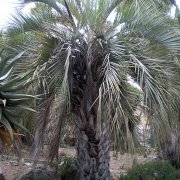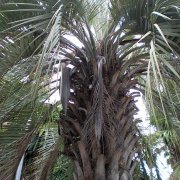Care of the palm tree Butia capitata or Jelly palm |
|
The genus Butia, Arecaceae family, comprises 20 species of palm trees native to Brazil, Argentina, Paraguay and Uruguay. Some species are: Butia capitata, Butia yatay, Butia eriospatha. Common names: Jelly palm, Pindo Palm Tree. This species is native to the states of Minas Gerais and Goiás in Brazil. They are short palm trees (up to 6 meters/19.68 feet high) but with a wide crown made up of long arched bluish leaves with leaflets located like the beards of a bird feather. They have showy inflorescences made up of small reddish or yellow flowers that give rise to edible fruits with an acidic flavor. Blooms in late spring. They are slow-growing palms that are used as isolated specimens to provide shade; young specimens are used as indoor plants. Butia capitata needs a full sun or semi-shade exposure outdoors and a very bright exposure indoors. It's ideal for gardens with a Mediterranean climate; it does not resist frost. The soil can be a garden substrate with manure. Planting is done in spring. Water all year round sparingly, except in spring and summer when watering is increased; it's resistant to drought. Fertilize with manure in the fall. Jelly palm does not need pruning, but dry leaves should be removed. Butia capitata is a plant resistant to pests and diseases. Pindo Palm Tree propagates by seeds but it's a very slow process. |
Images of the palm tree Butia capitata or Jelly palm |
Find plants
Butia capitata or Jelly palm | Care and Growing
© 2026 FavThemes

